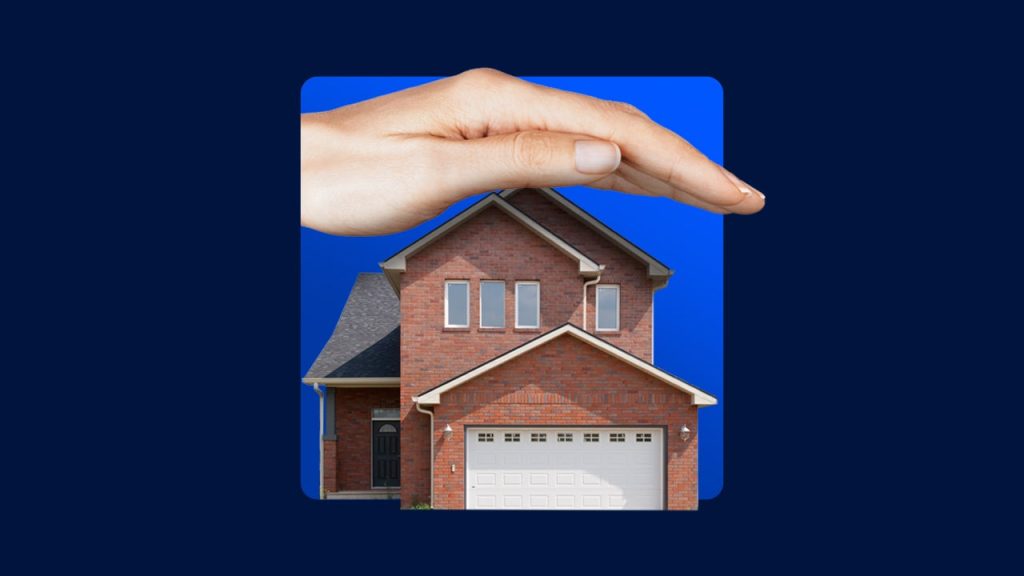Key takeaways
- There are many factors that affect the cost of home insurance, including your home’s specific features, the state you live in and the company you choose.
- Certain natural disasters, like floods and earthquakes, are excluded from a standard homeowners insurance policy and may require separate, specialized coverage.
- Understanding policy options, discounts and deductibles can help you select the best coverage for your situation.
Buying a home may be the largest purchase you make in your lifetime. Homeowners insurance offers financial protection for that investment. However, home insurance is not a one-size-fits-all product. The right policy for you will depend on a variety of factors like how much coverage you need, where you live, your personal belongings and more. Bankrate’s home insurance guide can give you the background you need to make an informed decision.
What is homeowners insurance?
Homeowners insurance exists to help cover one of your largest investments. At its most basic level, home insurance provides financial protection against various perils, or damaging events, that may affect your home, such as theft, fire and storms. Taken further, it also typically covers your personal belongings, additional living expenses and perhaps even legal fees if a guest is hurt in your home.
If you have a mortgage, your lender will likely require you to carry homeowners insurance. Depending on where you live, you might need flood insurance, too (this is typically a separate policy). When you purchase home insurance, you pay either a monthly, quarterly or annual premium. While it might seem like homeowners insurance is very costly, there are typically a wide variety of affordable options for most coverage needs and budgets.
Homeowners insurance coverage types
According to rates gathered from Quadrant Information Services, the average annual cost of homeowners insurance in the U.S. is $2,258 based on a home with a dwelling coverage limit of $300,000. Several types of coverage are included in most standard policies:
- Dwelling coverage: Also known as home structure coverage, dwelling coverage covers your home’s physical structure as well as attached structures like a garage.
- Personal property coverage: This coverage makes up a large portion of your homeowners insurance and is designed to replace your home’s contents after a covered peril, including clothing, furniture and appliances.
- Other structures coverage: This coverage may help cover the costs associated with repairing or replacing structures on your property other than your home that were damaged during a covered peril. Other structures may include a detached garage, storage shed, gazebo or fence.
- Personal liability coverage: This coverage may help financially protect you against potential legal fees from someone getting injured on your property.
- Medical payments coverage: This coverage operates similarly to personal liability but specifically covers the medical bills of someone injured on or in your property, regardless of fault.
- Additional living expenses (ALE): Also known as loss of use coverage, this helps cover extra temporary living expenses when you are displaced due to a covered peril. Covered expenses may include hotel stays, pet care, restaurant meals and laundry expenses.
In addition to what is covered, homeowners should also understand how certain things are covered under a home insurance policy. Your home’s dwelling, other structures and your personal property can be covered on either an open-peril or named-peril basis. With open peril coverage, your home and belongings are financially protected from every possible cause of loss except what is specifically excluded from your policy. Named peril coverage, on the other hand, is more limited. With named peril coverage, your home and belongings are only financially protected if they are damaged from a peril that is listed in your policy. Because open peril coverage is more comprehensive, it typically costs more than a named peril policy.
Types of home insurance policies
No guide to homeowners insurance would be complete without getting into the details of the different policy types. Different policy types offer different levels of financial protection:
- HO-1 policies: These provide bare-bones coverage for a home for perils such as fire, theft and vandalism. This kind of policy only covers specifically named perils and excludes liability coverage.
- HO-2 policies: These provide slightly more coverage than HO-1 policies and include some liability protection. HO-2 policies will cover detached structures, personal belongings and additional living expenses, but only from perils named in the policy.
- HO-3 policies: These are the most common homeowners insurance policy type and include all the basic coverage types. The key difference between HO-3 and HO-2 policies is that an HO-3 policy covers the physical structure of your home from open perils or any that are not explicitly excluded from your policy.
- HO-4 policies: These are designed for renters rather than homeowners. HO-4s typically cover 16 named perils, but coverage is limited to your personal property and does not include the actual structure since you do not own it. HO-4 policies also typically include additional living expenses coverage and liability coverage.
- HO-5 policies: These are the most robust homeowners insurance policies available and cover open perils for both your dwelling and personal property. Coverage for open perils means any peril not specifically excluded. Your insurance company will provide a list of perils that are not covered, such as damage due to neglect.
- HO-6 policies: These provide coverage for condominiums and have specific distinctions to account for what is covered — and not covered — by HOA policies. These policies, also known as condo insurance, typically cover the interior of your unit, personal property, personal liability, guest medical payments and loss of use.
- HO-7 policies: These are geared towards manufactured homes, like trailers, RVs and modular homes. Like an HO-3, your home’s physical structure is covered on an open peril basis, and personal property is covered on a named peril basis. These policies also usually include some form of liability, additional living expenses and medical payments coverage.
- HO-8 policies: The HO-8 home insurance policy is designed specifically for historic homes or older ones that are more challenging to replace. This may be because the homes have to meet historical society style standards or because they have older systems that are not commonly found in modern homes. These policies cover the dwelling and your personal property on a named-peril basis.
How much does homeowners insurance cost?
For a homeowners policy with $300,000 in dwelling coverage, the average cost is $2,258 per year. Individual rates may vary depending on the location, size and age of the home, coverage selections and many other factors.
Factors that affect homeowners insurance rates
Home insurance companies will typically calculate your individual insurance rate based on risk. They will look at several factors such as your location, the physical condition of your home, the type of building structure, the year your house was built and the cost to replace it to determine your home insurance premium. Other factors, both personal and financial (like your claims history and marital status), may also influence your premiums. Depending on your state, your credit history may also impact the cost of your home insurance policy.
You may be able to influence some of the factors that impact your homeowners insurance rate in order to get the most value for your dollar. Installing burglar alarms, security systems or sprinklers, for example, may earn you a discounted rate. If you live in an area that sees violent weather, such as coastal regions, your premium might be lower if you add mitigation measures like storm-resistant roofs or garage doors. Upgrading your home’s infrastructure, such as the plumbing or electrical system, could also earn you a better rate. Review your insurer’s available discounts to see if there are any that you might easily earn.
Lastly, talk to a licensed agent to make sure that you have the appropriate amount of coverage to financially protect your structures and property.
What does home insurance cover?
A homeowners insurance policy is designed to provide you with financial protection from a variety of damage-causing events, also called perils. Exactly what homeowners insurance covers and which perils are named or excluded on the policy may change based on your policy type and carrier. However, you can generally expect standard home insurance policies to include some kind of financial protection for the following:
- Hurricanes: Most homeowners insurance policies do not cover all aspects of hurricane damage. To be covered for flood and sewer backup-related damage, you may need to purchase additional coverage.
- Tornadoes: The U.S. experiences more tornadoes than any other country in the world. While tornado damage is typically included in home insurance coverage, homeowners who live in areas that experience a high number of tornadoes typically pay higher premiums.
- Theft: Theft coverage relates to personal property, but can also pertain to dwelling and other structures coverages as well, like if someone smashes a window in your home or garage during a break-in.
- Fire: Unless a fire was started intentionally in your home, damage will most likely be covered by your home insurance policy. Homeowners in areas with significant wildfire threat may see higher premiums or have difficulty finding coverage.
- Volcanic eruptions: Volcanic eruption coverage generally includes damage caused by volcano-related dust, ash and smoke in addition to fire.
- Weight from snow and ice: Snow accumulation can cause roof collapse, and the wet snowmelt can leave mold and wood rot in its wake.
- Vandalism: Vandalism coverage may include broken windows, graffiti and other deliberate property destruction.
Unique home insurance considerations
Even though your homeowners insurance policy should spell out pretty clearly what is included in your policy, there may be gray areas. The home features below may or may not be covered by your home insurance policy, depending on your carrier and the circumstances of the damage.
- Plumbing: Most homeowners insurance policies should cover plumbing-related damage unless it is the result of negligence, a long-term leak, old pipes or a sump pump.
- Septic tanks: Septic tanks are usually covered under the other structures portion of your policy, but coverage does not apply to wear and tear or negligence, such as if you let tree roots grow into your tank.
- Swimming pools: Some home insurance providers may not issue policies to homeowners with swimming pools, while others may require specific safety criteria in order to insure the home. Depending on the type of pool, it may be covered under the personal property or other structures component of your insurance policy. Pool-related injuries may also be covered by your liability or medical payments coverage.
- Trampolines: Based on your provider’s experience with trampoline-related claims, they may choose to include, exclude or cover them in a limited capacity. If covered, your trampoline itself may be covered under the personal property component of your policy, while injuries others sustain may fall under your liability or medical payments coverage.
- Items in storage: Items in storage may still be covered by your existing homeowners policy, but the coverage limits on those items might be lower than your personal property coverage limits for items in your home.
If you’re unsure about the coverage specifics of your home insurance policy, speaking with your insurance agent may help you understand what home features and perils are covered.
What does home insurance not cover?
Although each homeowners policy type provides different coverage, a standard HO-3 policy covers a variety of named perils except for losses that are specifically excluded. The following types of damage are typically excluded from a standard homeowners policy:
- Earthquakes, sinkholes or other earth movement
- Flooding
- Sewer or water backup
- Nuclear hazards
- Mold, rust and corrosion
- Insect infestations
- Regular tree removal
- Neglect
- Normal wear and tear or regular maintenance
- Power surges
- Local ordinances or government action
- Damage from pets
Even though an HO-3 is the most common policy purchased, you may still need coverage for these excluded losses depending on your location and personal needs. Coverage for these excluded losses may be available as standalone policies or endorsements to your existing policy.
Flood insurance for homes
Damage from floods is not covered under standard homeowners insurance policies, but flood insurance may be available through the National Flood Insurance Program (NFIP) and some private insurers. If you live in an area prone to flooding, your lender may require you to purchase flood insurance.
On average, U.S. homeowners spend $870 per year on flood insurance, although, like any insurance policy, your actual rates will vary. Experts recommend researching any areas you plan to move to so you know in advance if flood insurance will be necessary.
Other types of home insurance coverage
Other types of damage may be excluded from a standard homeowners insurance policy or coverage may be more limited. Coverage availability for these circumstances may depend on your location and carrier. Popular add-on coverage options include:
- Earthquake insurance: Earthquakes and earth movements are not covered in a standard homeowners policy. In most states, homeowners may be able to purchase an endorsement to cover damage from earthquakes. In California, homeowners may be able to purchase a separate standalone policy from either a private insurer or the California Earthquake Authority.
- Scheduled personal property coverage: High-value items like jewelry, art and collectibles are covered up to a certain dollar amount under a standard homeowners insurance policy. To ensure these valuable items are each covered for their full replacement value, homeowners may be able to purchase scheduled personal property coverage.
- Water backup coverage: This endorsement provides coverage if your home’s sewer or water lines back up into the drain, toilets or showers from issues like clogged pipes or broken drains. These lines are the homeowner’s responsibility if the failure occurs on their property and not at the main line. It may also cover sump pump failures, which could cause water to back up into the basement.
- Identity theft coverage: This endorsement may help pay for the costs of recovering your identity after it’s been stolen. Policy coverage can vary by carrier, but usually includes a dedicated caseworker, credit monitoring services, lost wages reimbursement and other restoration costs.
How much homeowners insurance do I need?
Our guide to homeowners insurance cannot tell you exactly how much coverage you need. Typically, insurance experts recommend purchasing enough coverage to rebuild your home and replace the value of the assets inside if it is destroyed. Having adequate coverage in place may reduce the chance of being left with costly out-of-pocket expenses following covered damage. It is important to note that the cost to rebuild your home is not the same as your home’s market value.
To get a rough estimate of how much homeowners insurance you may need, you might consider the square footage of your home, any upgraded or specialty construction elements and the monetary value of your belongings and furniture. This can provide a basis for the dwelling and personal property coverage amounts for your homeowners policy. Prior to finalizing your policy, experts recommend consulting a licensed agent to nail down optimal policy limits for your situation.
How to compare home insurance rates
While the core purpose of homeowners insurance is consistent regardless of the home insurance company you choose, every provider is unique in its policy offerings. Getting quotes from several companies may be a good strategy to compare rates and coverage offerings. To compare home insurance quotes, you may want to:
- Understand your needs: Knowing what you’re looking for in a home insurance policy may help you narrow down a list of potential companies and help you get a more accurate quote.
- Gather quotes: You may be able to get quotes online, by phone or through a local agency, depending on the company you choose.
- Review the coverage types and limits: Because each company has its own tool to determine the replacement value of your home, you might not be able to get quotes that are exactly the same. Getting the quotes as close as possible though, in terms of what coverage types and limits are included, may help you make a better comparison.
- Compare company features: Do you want a company with a mobile app? Is it important for you to have online tools? What about 24/7 customer service? Comparing features like this may help you find a company that you feel comfortable working with.
- Review third-party ratings: Looking at J.D. Power customer satisfaction scores and AM Best financial strength ratings may help you get a more well-rounded view of each carrier.
Homeowners insurance rates by state
Every state has unique factors, such as extreme weather events, that could affect your homeowners insurance premium. To start your home insurance search, it may help to know how your state compares to others in the nation. You might also consider looking into the common weather hazards and other factors associated with your ZIP code that may further influence your premium.
Homeowners insurance rates by carrier
Each carrier has a unique underwriting process and coverage offerings, so do not be surprised if you get different quotes from different insurance companies for the same coverage options. That is why most insurance professionals recommend getting quotes from multiple carriers so you can see which ones offer you the best coverage for your money.
Read the full article here









